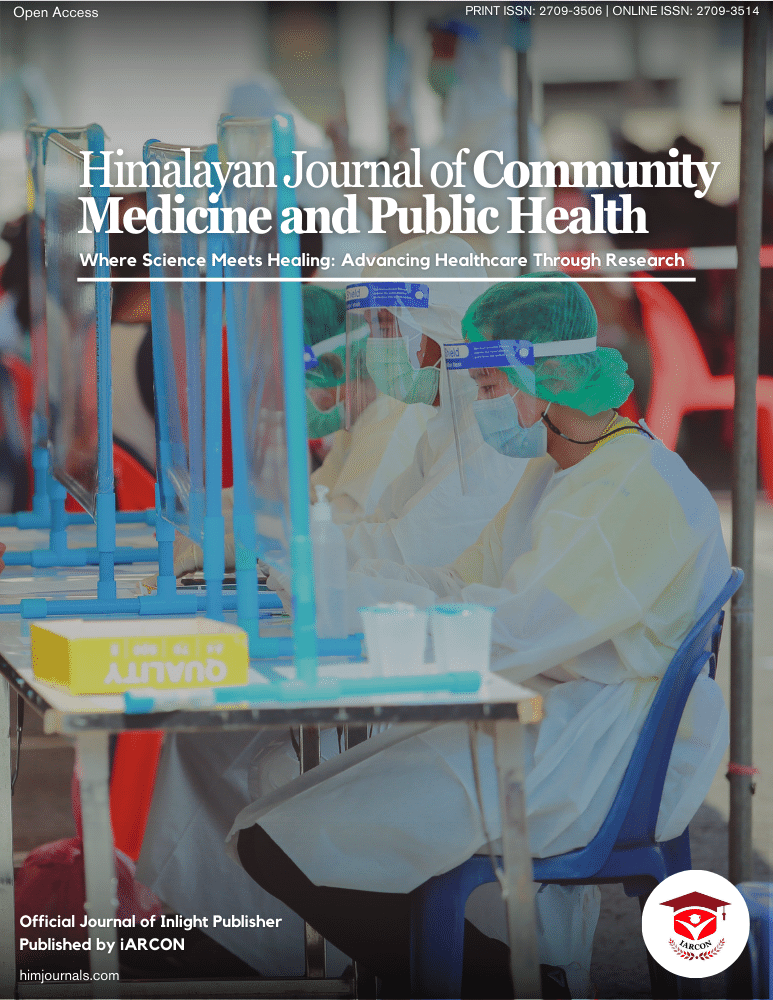This study offers critical insights into the level of awareness, risk perception and preventive behavior regarding cardiovascular diseases (CVDs) among middle-aged residents of Solan district, Himachal Pradesh. Given the mounting global and national burden of heart diseases and the increasing vulnerability of middle-aged adults, these findings are timely and provide a valuable foundation for developing localized and culturally relevant public health strategies aimed at mitigating cardiovascular risk.
The socio-demographic profile of the participants (Table 1) reveals that the majority (70.3%) were aged between 35 and 45 years, reflecting a younger middle-aged group that represents a prime target for preventive health interventions. The slight female predominance (52%) highlights the critical role women could play not only in safeguarding their own cardiovascular health but also in influencing health behaviors within their families. The educational distribution-where 66.3% had attained at least secondary education or higher-suggests a moderately educated population, which theoretically should facilitate the dissemination and uptake of health information. However, the rural predominance (67%) underscores potential challenges related to health service accessibility, health literacy variations and cultural factors that could impede effective CVD prevention and management efforts in these communities.
Knowledge regarding key cardiovascular risk factors (Table 2) was found to be generally encouraging but still leaves room for significant improvement. Most participants were well aware of traditional modifiable risk factors such as high blood pressure (81.5%), smoking (84.8%), obesity (79.5%), diabetes (77.8%) and high cholesterol (76.3%). Furthermore, strong awareness was demonstrated regarding physical inactivity (82.5%) and the protective role of regular exercise (82.0%) and healthy diets (80.3%). This promising level of foundational knowledge aligns with findings from other regional studies that emphasize growing general awareness, likely influenced by widespread health campaigns, media outreach and COVID-19-induced health consciousness. However, nuanced knowledge areas were less satisfactory: only 66.5% recognized that CVDs could be asymptomatic in early stages-a critical knowledge gap that could delay timely risk assessment and intervention. Furthermore, misconceptions were evident, with 35% of participants incorrectly viewing regular exercise as a risk factor, indicating confusion between preventive behaviors and risk contributors. Awareness regarding the importance of monitoring blood sugar and salt intake, although relatively high (70.3% and 78.5% respectively), also points to lingering knowledge gaps that must be addressed to ensure comprehensive risk management.
The knowledge classification (Table 3) revealed that while a substantial proportion of participants demonstrated "Very Good" (32%) and "Good" (42.5%) knowledge, a concerning 25.6% (combined "Fair" and "Poor") exhibited limited understanding. These participants represent a vulnerable segment of the population that could benefit most from focused educational interventions. Similar patterns have been observed in national and international studies, where baseline awareness exists but is insufficiently deep or actionable, particularly when it comes to understanding asymptomatic disease progression, non-traditional risk factors and the critical need for proactive health monitoring.
Lifestyle transitions in Solan, as mirrored across rural India, are likely contributing significantly to rising CVD risk. Traditional protective factors-such as higher physical activity due to agrarian lifestyles-are being eroded by increased mechanization, indoor occupations, dietary shifts toward processed foods and persistent tobacco and alcohol use. Compounded by socio-cultural barriers, low-risk perception among asymptomatic individuals and limited routine engagement with preventive health services, the conditions are ripe for a looming cardiovascular epidemic even in semi-rural settings.
From a public health perspective, these findings emphasize the urgent need for a multi-pronged approach. First, health education campaigns should move beyond basic awareness and focus on deepening the public’s understanding of silent risk factors, early warning signs and the asymptomatic nature of early-stage CVDs. Messaging must be clear, relatable and delivered through trusted local sources including Accredited Social Health Activists (ASHAs), school teachers, community leaders and healthcare providers. Second, interventions must actively address behavioral translation-turning awareness into preventive action. Campaigns promoting routine blood pressure, cholesterol and glucose monitoring, along with sustainable lifestyle changes such as daily exercise, salt restriction, smoking cessation and balanced diets, should be prioritized. Third, addressing rural-urban disparities by enhancing access to primary preventive services in rural Solan-through mobile health units, periodic screening camps and integration of CVD risk assessments into existing health programs-will be crucial. Fourth, considering the 20.3% unemployment rate among participants, economic barriers to accessing health-promoting resources such as medical check-ups, medications and fortified foods must also be factored into policy planning [7-9].
Additionally, the strong trust indicated in healthcare providers (85% preferring cardiologists or doctors for risk assessment) provides an opportunity: empowering primary care physicians and community health workers to offer early cardiovascular screening and counseling can bridge existing gaps cost-effectively. Simultaneously, the low awareness regarding asymptomatic CVD and misinterpretations about preventive behaviors highlight the need to incorporate targeted myth-busting and culturally sensitive narratives into communication strategies.
In summary, while the awareness of classical cardiovascular risk factors among middle-aged adults in Solan district is relatively robust, significant gaps persist in nuanced knowledge and preventive behaviors. Bridging these gaps through sustained education, community empowerment, accessible preventive services and culturally tailored interventions will be essential to reducing the future burden of cardiovascular diseases in this critical demographic group. Left unaddressed, the silent progression of CVD risk factors will continue to translate into a rising tide of preventable morbidity and mortality, straining families, healthcare systems and society at large.

